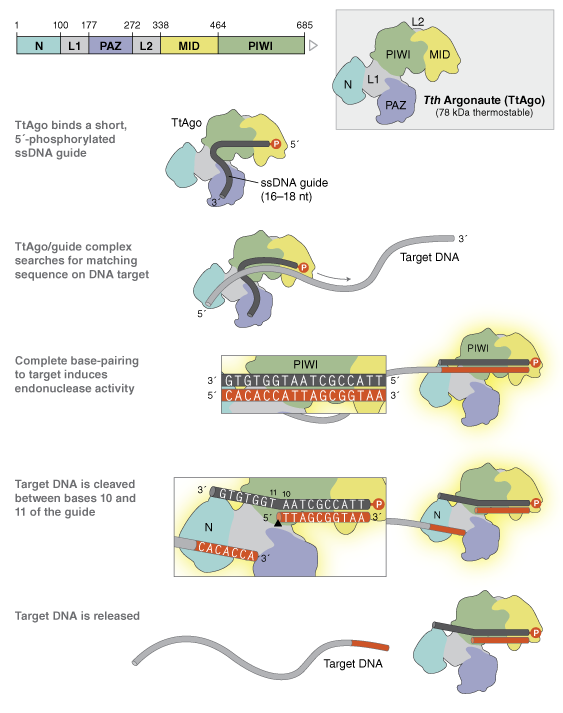上海金畔生物科技有限公司代理New England Biolabs(NEB)酶试剂全线产品,欢迎访问官网了解更多产品信息和订购。
产品信息

TtAgo 在 65–85℃ 时具有活性(请见产品使用说明 #2),对单链 DNA(ssDNA)活性最高,其次是双链 DNA(dsDNA),对单链 RNA(ssRNA)底物活性最低。TtAgo 与单链向导 DNA 协同作用时,不会切割双链 DNA(dsDNA)底物,只是在与向导 DNA 的互补链上产生切刻。该酶对双链 RNA(dsRNA)底物无活性。切割后的 5ʹ 和 3ʹ 末端产物可进行下游连接(1)。研究表明,在某些情况下,加入热稳定单链 DNA 结合蛋白(ET SSB,NEB #M2401)和/或热稳定解旋酶,有助于切割 dsDNA 底物。
在无向导 DNA 的情况下,TtAgo 会通过一种“剪切”的方式来降解双链 DNA(dsDNA),这被认为是 TtAgo 利用入侵或外源 DNA 自发产生了向导 DNA 的机制(2)。为了防止这种非特异性活性的产生,向导 DNA 的摩尔量需超过 TtAgo 量的 5 倍。此外,向导链要与 TtAgo 一起在大约 75℃ 条件下孵育 10-30 分钟,先形成核蛋白复合物后再加入底物进行反应。如需了解更多详细信息,请参阅“操作说明、说明书 & 用法”部分。
TtAgo 适用于体外应用。
如需定制大包装或高浓度的产品,请联系 NEB 的客户定制解决方案部门购买定制大包装产品。如需了解更多信息,请联系 [email protected]。
产品来源
嗜热栖热菌 Argonaute 蛋白(TtAgo)纯化自携带有克隆革兰氏阴性嗜热栖热菌(Thermus thermophilus)基因的大肠杆菌菌株,其 N 末端融合表达 6X His 标签。
- 产品类别:
- Argonautes Products,
- Programmable Nucleases Products
-
产品组分信息
本产品提供以下试剂或组分:
NEB # 名称 组分货号 储存温度 数量 浓度 -
M0665S -20 Tth Argonaute (TtAgo) M0665SVIAL -20 1 x 50 pmol 1 µM ThermoPol® Reaction Buffer B9004SVIAL -20 1 x 1.5 ml 10 X
-
-
特性和用法
稀释兼容性
- 稀释液 B
贮存溶液
10 mM Tris-HCl
300 mM NaCl
1 mM DTT
0.1 mM EDTA
50% Glycerol
pH 7.4 @ 25°C热失活
否
-
相关产品
相关产品
- T4 多聚核苷酸激酶(T4 PNK)
- ThermoPol® 反应缓冲液套装
- Nuclease-free Water
- 超热稳定单链结合蛋白(ET SSB)
-
注意事项
- 1X ThermoPol® 反应缓冲液中 Mg2+ 以 2 mM MgSO4 的形式存在,可适用于大多数应用。Mn2+ 也可以被 TtAgo 利用,但是应该以低约 10 倍的浓度下使用,因为高浓度的 Mn2+ 会抑制 TtAgo 的活性,并且会导致高温条件下非特异性底物降解,尤其是对 RNA 底物。如需了解更多信息,请参阅常见问题和 Tth Argonaute 蛋白(TtAgo)反应优化指南。
- TtAgo 蛋白在 65–85+℃ 范围内具有活性。常规反应条件为 75– 80℃ 之间。如果温度低于 70℃,活性会急剧下降。如需了解更多详细信息,请参阅技术文献指南。
- 具有 5´ 磷酸末端的向导 ssDNA 长度为 16–18 个核苷酸,可在合成后使用NEB T4 多聚核苷酸激酶(T4 PNK)进行磷酸化。
- 向导寡核苷酸的摩尔量应超过以 TtAgo 量的 5 倍。
- 稀释液 B 可用于稀释 TtAgo。稀释后溶液应储存于 -20℃。
-
参考文献
- Hunt, E. A., Evans Jr, T. C., & Tanner, N. A. (2018). Single-stranded binding proteins and helicase enhance the activity of prokaryotic argonautes in vitro. PloS One. 13 (8), e0203073.
- Swarts, D., Szczepaniak, M., Sheng, G., Chandradoss, S., Zhu, Y., & Timmers, E. et al. (2017). Autonomous Generation and Loading of DNA Guides by Bacterial Argonaute. Molecular Cell.. 65 (6), 985-99.
- Wang, Y., Sheng, G., Juranek, S., Tuschl, T., & Patel, D. (2008). Structure of the guide-strand-containing argonaute silencing comple. Nature. 456(7219), 209-213.
- Swarts, D., Jore, M., Westra, E., Zhu, Y., Janssen, J., & Snijders, A. et al. (2014). DNA-guided DNA interference by a prokaryotic Argonaute. Nature. 507(7491), 258-261.
- Sheng, G., Zhao, H., Wang, J., Rao, Y., Tian, W., & Swarts, D. et al. (2013). Structure-based cleavage mechanism of Thermus thermophilus Argonaute DNA guide strand-mediated DNA target cleavage. Proceedings Of The National Academy Of Sciences. 111(2), 652-657.
操作说明、说明书 & 用法
-
操作说明
- Protocol for generating break in phosphodiester backbone with Tth Argonaute (TtAgo, NEB #M0665)
- Protocol for creating 5′-Phosphorylated Guides from Unmodified Oligonucleotides for use with TtAgo (NEB #M0665)
- High-throughput protocol for phosphorylation of guide oligonucleotides in 96-well PCR plate format (NEB #M0665)
-
使用指南
- GUIDElines for optimization of Tth Argonaute (TtAgo) reactions
-
应用实例
- GUIDElines for optimization of Tth Argonaute (TtAgo) reactions
FAQs & 问题解决指南
-
FAQs
- Can I prepare functional guides for TtAgo from unmodified synthetic oligosCan I prepare functional guides for TtAgo from unmodified synthetic oligos?
- Some guides do not seem to be working as well as others with TtAgo. What can be done?
- How can I reduce non-specific endonuclease activity with TtAgo?
- Can I store TtAgo with a guide “loaded?”
- Is TtAgo active in other NEB buffers?
- Is TtAgo active at other temperatures?
- How much Mg2+ [magnesium(II)] should be included in a typical reaction?
- What if I want to use TtAgo with Mn2+ [manganese(II)] instead of Mg2+ [magnesium(II)] as provided in ThermoPol® Reaction Buffer?
